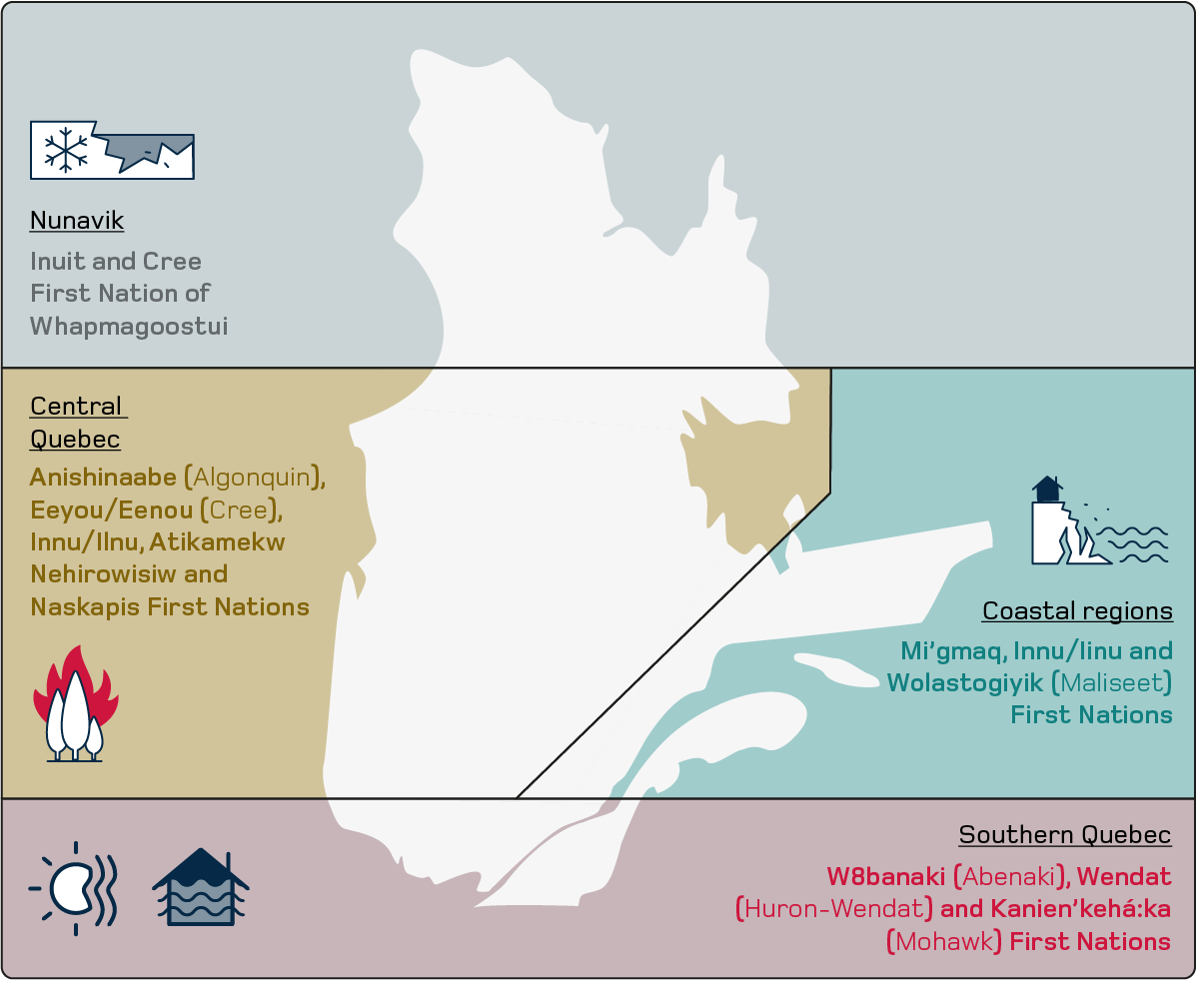Issues of climate change on Indigenous peoples
Climate change is exerting significant pressure on the First Nations and Inuit (FNI) in Quebec, affecting things like infrastructure, cultural and subsistence activities, and the physical and mental health of Indigenous peoples.
Although impacts vary depending on the geographic region and the specific lifestyle of each community, common trends emerge from the observations made by the FNI. It’s worth noting that these impacts overlap with other major issues facing the FNI, such as the effects of colonization.
On this subject, note that colonization has, among other things, brought about:
The creation of reserves, often in areas exposed to climate hazards
The reduction of ancestral territories, which limits gathering, hunting and fishing activities
The loss of cultural practices
Infrastructure and travel
Climate change causes major problems in terms of infrastructure, travel and access to land for both Indigenous and non-Indigenous communities. The FNI are coping with challenges defined by their way of life, the way infrastructure is managed, and the impacts of colonization. For example, the location and boundaries of several Indigenous reserves lie in flood plains.
The following figure provides an overview of the wide variety of impacts on infrastructure in Quebec:

Figure 2: Examples of major impacts on infrastructure in four regions of Quebec, and the people affected.
Access to the land and safe travel
Some Indigenous communities living in northern regions are having to reconsider their winter roads. Historically, and still today, they use ice roads to get around and to practice their traditional and subsistence activities.
For the Inuit communities of Nunavik and for many First Nations communities, the shorter cold season and reduced ice cover make access to certain areas more difficult. This new reality jeopardizes the safety of hunters and anyone else travelling on these roads in the winter.
Evacuations and relocations
With extreme events becoming more frequent, longer-lasting and more intense, some Indigenous communities are at greater risk of being displaced or relocated.
Forest fires disproportionately affect Indigenous communities living in central and northern Quebec, in the remote forested areas where these events occur more often. For example, during Quebec’s historic forest fire season of 2023, the W8banaki (Abenaki) Nation recorded over 10,000 evacuees from 13 communities, out of a total of just over 38,000 evacuees in Quebec.
Beyond the evacuations they caused, the 2023 forest fires also dramatically transformed First Nations territories. The hunting grounds of the Eeyou/Eenou (Cree) and Anishinaabe Nations, located in boreal areas, were particularly hard hit.
Food systems and subsistence activities
The FNI in Quebec are witnessing significant changes in seasonal conditions, which are disrupting ecosystems and altering traditional subsistence practices such as hunting, fishing and gathering. These practices have been relied upon for many generations and are crucial to ensuring the food security and sovereignty of Indigenous peoples.
Hunting
Hunters and trappers have seen changes in the behaviour and range of some species in northern Quebec, while others, such as caribou, are becoming less abundant.
Hunting and trapping activities are also disrupted by forest fires. For example, during the 2023 forest fire season in Quebec, several hunting cabins and trap lines burned. Most of them were not covered by insurance, and access to these cabins was sometimes very difficult due to the damage caused by the fires.
Fishing
The fishing season is greatly curtailed by the dangers of thin ice and water surges that can sweep away fishing huts. Traditional knowledge of ice safety is being lost, and younger generations don’t know how to recognize safe spots. Some Indigenous community members have also observed a decline in the quality of the fish consumed in their communities.
Gathering
In the south of the province, berries have become less abundant, while in the north, the densification of shrubs is detrimental to species that aren’t adapted to shade. Several community members have also reported that medicinal plants in their area are disappearing or drying up due to higher temperatures and longer periods of time without precipitation.
Arts and crafts
The arts and crafts practiced in certain communities must also be adapted to climate change. For example, the traditional ash basket production by the Mi’gmaq, Kanien’kehà:ka (Mohawk) and W8banaki (Abenaki) communities is now threatened by the emerald ash borer, whose spread is favoured by a warmer climate.
Health and wellness
There is an intersection between Indigenous and non-Indigenous peoples when it comes to the health impacts of climate change. However, it is important to note the particular vulnerability of Indigenous peoples due to their proximity to and dependence on the environment and natural resources, and the fact that their lands tend to be located in regions affected by accelerating global warming.
The direct and indirect impacts of climate change on the physical health and wellbeing of these communities are profound and interrelated, exacerbating pre-existing socioeconomic and health inequalities. Mental health can also be affected, particularly by disruptions to lifestyle aspects such as hunting and fishing.
The impacts of climate change on physical and mental health vary between different Indigenous communities and between members of these communities. Due to this, there is a need for more culturally sensitive research and adaptation measures that take the specific needs of Indigenous peoples into account.
Learn more about the impact of climate change on the health of Indigenous peoples in Canada.